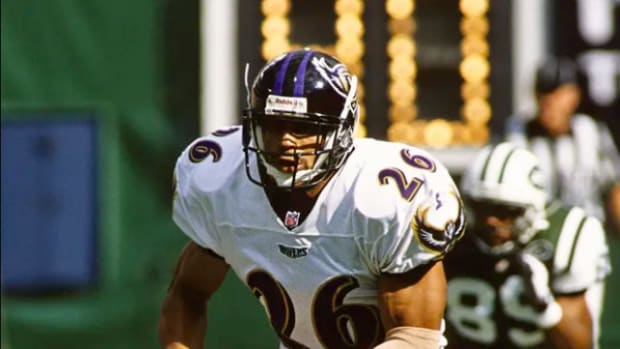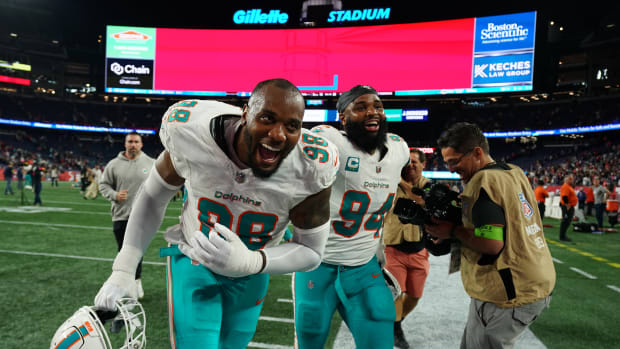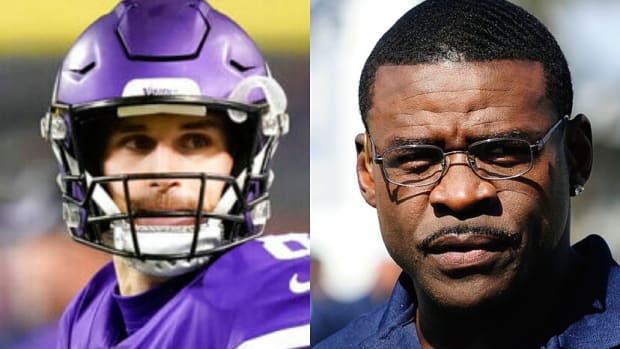How NFL Draft Prospects Are Learning to Protect Themselves From Social Media Snafus
At the NFL Scouting Combine in 2013, a prospect walked into his 15-minute interview with a team and, to his surprise, was handed a stack of papers as thick as a novel. He flipped through the heavy pile, expecting to see blank play diagrams for some board work. Instead, each page was full of old tweets, taken straight from his own Twitter timeline.
A sampling:
I want some mac and cheese… smh this curfew… on the road again... don’t even know … ready for dinner… takin care of business…
On one day during the season, he’d sent 26 tweets, announcing his every move as the day went on. His agent had talked to him about toning down his Twitter presence during the pre-draft process, but he hadn’t taken that advice seriously. He’d never tweeted anything inappropriate, so he didn’t see what the fuss was about. Now, as he sat in front of a group of team personnel and held the ridiculous weight of his unimportant status updates in his hands, he finally understood.
What the f--- do you want to do? the team’s decision-makers asked him. Tweet or play football? If you want to play football, how the f--- do you have time to prepare or play when you are tweeting every five seconds?
Needless to say, that team did not draft this prospect, but another team did. After that fateful combine meeting, the prospect slightly curtailed his serial tweeting. But he still tweeted enough to annoy most teams and lead many to believe he was going to be a bad locker room guy, a me-first guy instead of a team-first guy. Since then, he’s been a team captain and Walter Payton Man of the Year nominee, and is now among the higher-paid players at his position.
“When Twitter started taking over, teams didn’t understand it,” said the player’s agent. “They didn’t like the players having another way of sharing their voice.They really don’t want any of them having non-football thoughts or focuses, so teams were freaking out.”
And the NFL hasn’t stopped freaking out since. In the past few years, several players have triggered very visible draft day social media freak-outs (Laremy Tunsil in 2016 and Josh Allen in 2018) and the projected top two picks this year have both already felt the impact of their own social media presence. A day after Oklahoma QB Kyler Murray won the Heisman Trophy, he apologized for old tweets of his that had surfaced. In tweets he’d sent as a 14- and 15-year old, he’d called friends homophobic slurs. And Ohio State edge rusher Nick Bosa, widely viewed as the likely second overall pick, recently explained his decision to delete tweets that expressed support of President Trump and criticism of Colin Kaepernick.
Most teams and agencies now analyze social media in-house, but several businesses are clamoring to bring social media expertise to the market. Turnkey Intelligence developed a product specifically for the NFL, and is currently selling a social media report that analyzes the top 100 prospects’ behavior on social media. Turnkey Intelligence found that 60 percent of this year’s top 100 prospects have used derogatory and curse words on social media, 23 percent have shared or engaged with explicit social content, 19 percent have shown or insinuated drug or alcohol use on social media and seven percent shared a strong political viewpoint that may be considered polarizing. One prospect deleted 11,500 total social posts.
This is the work going on behind the scenes. Prospects are desperately deleting old tweets, agents are putting out fires before they even set off alarms, teams are devoting more resources to vetting the social media accounts of their top prospects and colleges are training their athletes to be cautious on social media.
I polled eight different agents from seven different agencies for this story, and only one—the smallest of the agencies I spoke to—does not have a protocol in place to cleanse clients’ social media profiles. The rest of the agencies all said they have a person, or several people, on staff who manually review every social post, a mind-numbing task that requires hours and hours of scrolling, depending on the volume of posts per client. “It is so tedious and monotonous but it is so important,” said Alyssa Romano, VP of communications for Octagon. “I tell the people who work for me, ‘I know your eyes are going to glaze over, but one tweet could mess up this client’s entire career.’”
“Given what has transpired the last couple years,” one agent said, “if you don't do that, it's malpractice.”
Another agent said it can be difficult to coax passwords out of clients. Some players refuse the agency access to their accounts because they don’t want them to see how they use their platforms to pick up women. If the client has an overwhelming amount of social posts, some agencies choose to outsource the review to a third-party consulting firm.
Romano says Octagon tightened up its social media review practices after Josh Allen’s old tweets with racial slurs surfaced the day before he was drafted by the Bills last year. Octagon even added a line to their recruiting pitch about offering social media cleanup. “I vividly remember sending an email to everybody saying, next year, this is not happening to us,” Romano said. “We really have to hone in on it.”
The agency that represents Allen, Creative Artists Agency, has had a social media protocol in place for several years. They did review and scrub Allen’s account when they signed him as a client, as they do for all their clients. A Yahoo reporter still found a few offensive tweets from Allen’s high school days lingering live on his timeline.
Agents are in a tough spot. They don’t officially sign prospects until January, after the prospect is done playing college football. And by then, it’s often too late. The agency can delete all the tweets they want, but if the player is a big enough name in the draft, someone out there has probably already screenshotted anything problematic as permanent evidence. Murray, who is projected to be the first overall pick, joined Twitter in April 2011, when he was 14 years old. By the time he was 15, he had 30,000 followers and had won his first of three 6A Division I Texas state championships. He was already becoming a name, and well on his way to five-star recruit notoriety.
Agents I spoke to all described a feeling of helplessness because no social media cleanse is foolproof, however vigorous it may be. What if their client tweeted something horrible and quickly deleted it years ago, but someone screenshotted it at the time? That won’t show up on any search when the agency scrubs his account.
Extortion is also rampant issue. Agents I spoke with complained about receiving demands for payment from people who claim to have screenshots of NFL players’ old tweets, or pictures or videos of the player that they sent to someone years earlier.
While watching a current client work out at his pro day in March, one agent whispered a story about how he’d narrowly avoided a nightmare situation with another client when he was a draft prospect. A few years ago, the agent got a call around midnight about two weeks before the draft. It was one of his prospects, telling him he just found a video of himself online and needed it taken down immediately. “Please don’t watch it,” the player begged. “But I need help. Get it off the internet.”
The agent reluctantly clicked on the link. He had to watch the video to understand exactly what his client was referencing. It was a video taken of a video chat between the client and a woman. The prospect was naked and having a sexually explicit conversation with the woman. He had no idea she was recording the whole video call. “It was so uncomfortable,” the agent said. “I did not sign up for this work.”
The video was posted on an obscure website, and the agent immediately sent a cease and desist letter to the site that forced them to take down the video. It was removed from the site within 48 hours. No one in the league ever discovered it, and his client, who is still playing in the NFL, was a late-round draft pick that year. “If that video had come out, I don’t think he would have been drafted,” the agent said.
That type of threat to a client’s reputation won’t come up on your standard social media profile search.
Many major college athletic programs teach their student-athletes about the dangers of social media, but by college age it may be too late. Many of the players in this draft class have been using social media since 2011, when they were 14 years old. Because of this, one agent said his agency will sometimes recommend prospects delete every post more than three years old, to help minimize risk.
Josh Jacobs, widely viewed as this draft’s top running back prospect, says every freshman football player at Alabama takes a communications course in the summer that teaches them not just how to handle interviews, but also the do’s and don’ts of social media.
The Clemson prospects in this draft might be the least at-risk of a social media shaming, because at Clemson the players instituted their own “no posting during the season” rule. The seniors in 2014 came up with the idea of social media abstinence and the program has stuck with it ever since.
The agent whose agency does not have a process to scrub social media in place told me he’s not that worried about the issue because he only recruits, “high character guys.” When pressed with the thought that many would have considered Josh Allen to be a good guy before his tweets were exposed, he said: “Well, that’s a good point…” And then he trailed off.
With that in mind, I decided to check out my own social media history, with the help of an online cleanup tool by BrandYourself, which costs $10 for a one-time cleanup. (And if you’re a draft prospect reading this, they are running a promotion so you can use this tool for free.) BrandYourself flags posts and sorts them into seven offensive categories ranging from bigotry to profanity to sexual content. I didn’t think anything would show up on my results besides some harmless profanity, because to use the agent’s words, I’d consider myself a “high character guy.” The tool ran searches on my social media profiles and announced that it had flagged 227 of my social posts. 227? I was surprised to discover a few vulgar posts in the sexual content category. But during my freshman year in college, my friends and I would routinely hack each other’s Facebook statuses whenever someone left their computer unattended. I’d forgotten about them and had clearly never deleted them.
“If you ask the average person, ‘Do you think social media gets looked at and can be damaging?’” BrandYourself CEO Patrick Ambron said, “Everyone says yes. But when you ask the individual, ‘Do you think you have anything out there?’ Almost everyone says no. It's that invincibility thing. They just assume they are a good person they wouldn't do anything to get them into trouble.”
When asked if he’d gone through his social media recently to make sure nothing would jeopardize his draft stock, Jacobs, a potential first-round pick said, “No, I don’t need to because I know what I post and I never post anything too crazy. “
The most common inappropriate content found on prospects’ accounts, according to Turnkey Intelligence and the agents I spoke to, are homophobic and racial slurs—often used to refer to friends or quoting rap lyrics—and pictures and references to partying or smoking.
Agents generally feel that what a prospect puts out on social media is meaningless from a football standpoint, important only if the player cares about future marketing deals. “Teams don’t care as much as people think,” an agent said. “They only care to make sure it's not going to impact their locker room.”
Allen’s talent outweighed his risk, and his draft stock didn’t seem to be affected by his tweets. The Bills traded up to take him seventh overall, and the team even tried to trade up higher for him. Teams have shown us repeatedly that talent will outweigh most character concerns, even the most serious ones, but in some cases, social media can still have a direct impact on the decisions teams make.
The infamous Laremy Tunsil situation in 2016 was the perfect storm. A few minutes before the first team was on the clock, a video of Tunsil smoking a substance from a gas mask bong was posted to his own Twitter account. His agent said he was hacked. The Ole Miss tackle was projected to be a top five pick, but he slid until the Dolphins picked him at No. 13. That year, the Giants picked 10th, and had a need for a left tackle. A former Giants employee says they took Tunsil off their draft board because of the video. Tunsil already had a couple red flags and the video just amplified those concerns.
“We would have taken him there, but there was too much uncertainty and not enough time to figure it out,” he said, looking back. “When an owner sees that 20 minutes before the draft, there is no way. It was just one of those, ok, well he is off the board. It wasn’t even a discussion.”
The Giants took Ohio State cornerback Eli Apple instead. Apple’s tumultuous Giants career has already ended with a trade to New Orleans. Meanwhile, Tunsil has been quietly playing at a Pro Bowl level in Miami, without any further off-field issues.
A scout’s job is to know as much information as he can about the prospects in his area that he is responsible for writing reports on, so the job often calls for scrolling through prospects’ social media history. “Teams use social media as another tool to develop a personality and character profile on the players they are scouting,” one agent said. “It’s an insight into their character evolution, growth, or in some cases, disintegration. The players are volunteering themselves to the world.”
One scout said he scrolls back as far as he can in the posts for the top guys in his area, but often doesn’t have to spend too much time, because, “Many say stupid stuff still as recent as the last year.”
Several teams I spoke to put scouting assistants or interns in charge of monitoring social media accounts for top prospects. They’ll hand them a list and the assistants will spend the season noting anything concerning. Others wait until closer to the draft and pay consulting firms for social media reports on the top 100 or so prospects on their board.
In March and April, teams monitor prospects’ social media use for another reason: to get a competitive edge in the draft process or protect their own information.This year, one prospect posted his city location on his Instagram story while on a visit to an NFL team in that city. That team’s general manager called the player’s agent to ask him to take it down because he didn’t want other teams to know they were interviewing the player.
Peak social media shaming season is upon us with the NFL draft beginning Thursday. The outings are so common that one agent has started working even further ahead. Now when he starts recruiting players, rising sophomores about to hit college football fame, he tells them to go through their social media profiles now, so they can clear their feed before they become a target. “One guy I told it to, I’m thinking in my head, hmm... you go to a big school and your rival hates you,” he said. “If you had something out there when you were 18, somebody already has it.”
• Question or comment? Email us at talkback@themmqb.com.




































